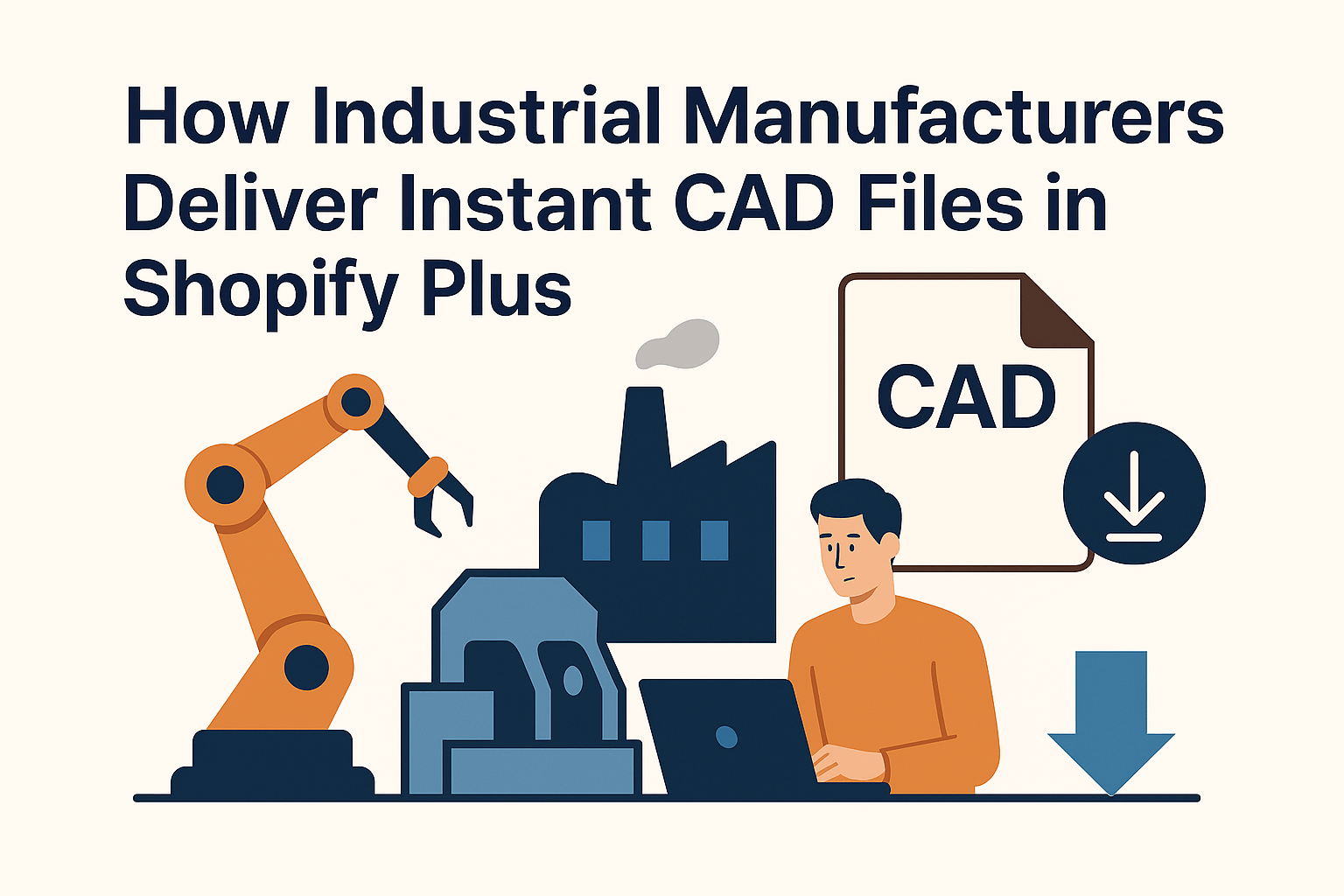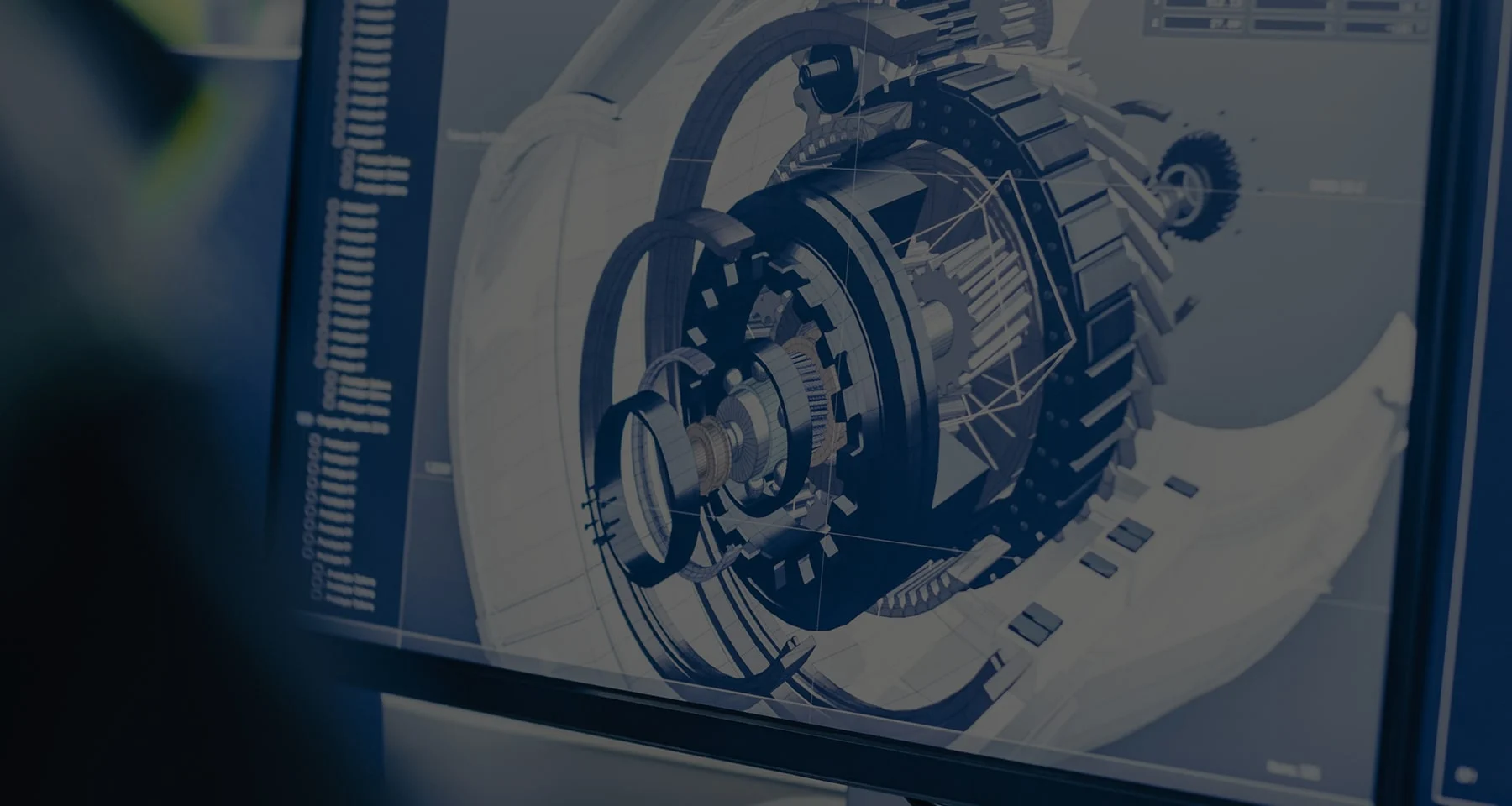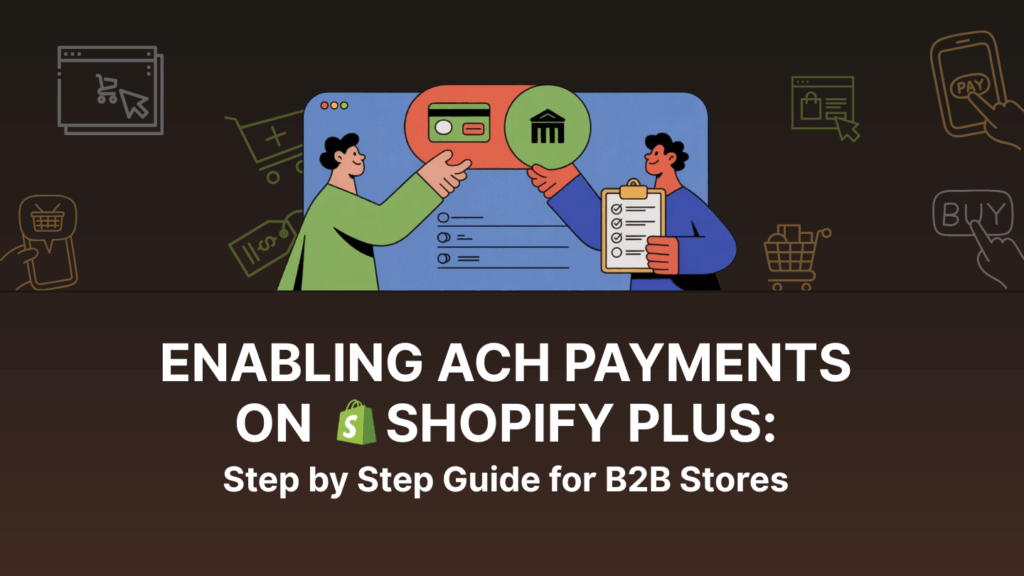Why CAD Access Is the Bottleneck in Industrial Sales
An engineer sits in front of their workstation, deadline looming. They’ve selected the industrial component they need: a custom coupling, a specialized valve, and a bearing with nonstandard dimensions. The design can’t move forward until they drop the CAD file into their assembly model. Without it, simulations can’t run, tolerances can’t be checked, and approvals can’t be signed off.
So they send an email to the supplier’s sales engineer: “Can you send me the CAD for this configuration?” Then they wait. Sometimes it’s a few days. Sometimes it drags into weeks. And in that silence, momentum dies. Other parts of the project grind to a halt. Meetings are delayed because no one has the file they need. The engineer grows restless, and quietly starts looking at competitors who can give them what they’re asking for immediately.
This scene happens every day in industrial manufacturing. CAD files aren’t a courtesy; they’re the lifeblood of engineering workflows. They determine whether a component can even be considered for purchase. Yet for most suppliers, CAD delivery is still a slow, manual process hidden behind email chains and overloaded sales teams.
That’s the gap. Not the quality of the component. Not the reliability of the supplier. The gap is speed. The moment between when an engineer configures a part and when they can drop it into their design. The suppliers who shorten that gap win trust early. The ones who don’t are quietly written out of the project before they even know they are competing.
This is why industrial manufacturers are now rethinking their e-commerce strategies. Shopify Plus isn’t just a storefront for SKUs, when integrated with CAD engines, it becomes the delivery mechanism for live CAD files tied directly to custom configurations. Done right, it means an engineer can log in, configure a part, and download a CAD file instantly, without waiting for anyone.
And that changes everything. It accelerates design cycles. It keeps procurement aligned. Most of all, it turns a supplier from a slow gatekeeper into a trusted partner who moves at the speed of engineering.
The Engineer’s Perspective: Why Speed Matters
Ask an engineer what slows them down, and you’ll rarely hear them complain about the work itself. The stress comes from waiting. Waiting on approvals. Waiting on suppliers. Waiting on a CAD file that they can’t move forward without.
You can picture the scene. They’ve got a full assembly model open with hundreds of parts already placed, and one custom coupling is still missing. Everything else is ready, but without that file, the design can’t move. They can’t run load tests. They can’t push the draft to their manager. They can’t even answer the simplest question in the project meeting: “When will this section be finalized?”
And here’s the thing: engineers aren’t patient by nature. They work against hard deadlines. A delay doesn’t just frustrate them; it exposes them. Every day the file doesn’t arrive is another day they have to sit in meetings empty-handed, another day they carry the blame for a project slipping.
That’s why speed matters more than most suppliers realize. A two-day wait for a CAD file might not sound like much in the office upstairs, but to the engineer sitting in front of their screen, it’s the difference between progress and paralysis.
When a supplier makes those files instantly available, the feeling is almost visceral. The engineer drags the file into their model, runs the test, and keeps going. No back-and-forth. No apologizing in meetings. No helpless waiting. Just momentum.
And momentum is everything in engineering. Lose it, and projects stall. Protect it, and trust builds fast. Suppliers who understand that don’t just deliver CAD files; they deliver breathing room in a job where deadlines always loom too close.
Why Traditional CAD Delivery Fails
The Email Dance No One Wants to Do
An engineer spots the part they need and sends off an email, or worse, fills out a form that feels like it drops into a black hole. On the supplier’s side, the request lands on a desk already buried in fifty others. The file might be dragged from an old library. Or it might need to be generated from scratch. Either way, the engineer waits.
The Wrong File at the Wrong Time
Even when the file finally arrives, it’s often off: wrong dimensions, outdated revision, or in a format the engineer’s software refuses to read. Back goes another email “This isn’t the one I need. Can you resend?” Days slip by. The project stalls. Everyone loses momentum.
A Workflow Built on Fragile Threads
The process depends on email chains that get lost, attachments blocked by IT filters, and files sitting on someone’s desktop instead of in the system. No one has visibility until the file either shows up — or doesn’t. The fragility isn’t just inconvenient. It makes engineers feel exposed and suppliers look unreliable.
Sales Engineers Turned Into Clerks
For suppliers, the pain runs deep too. Sales engineers spend hours hunting through folders, fixing drawings, and resending files instead of solving real problems. Reps are pulled in as middlemen, apologizing for delays they didn’t cause. It’s demoralizing, and it robs teams of the time and focus they need to actually move business forward.
Why This System Can’t Be Saved
The failure isn’t about laziness or incompetence. It’s structural. A process built on human follow-up will always crack under pressure. And in industrial sales, where trust lives or dies on responsiveness, every crack becomes a reason for engineers to quietly drift toward a competitor who can move faster.
The Role of Shopify Plus in Industrial Ecommerce
When most people think of Shopify, they picture a clean storefront for consumer goods. But in industrial manufacturing, Shopify Plus is becoming something different. It’s the front door to the business, the place engineers and procurement teams go first to configure, price, and order components.
The catalog is already there, and the configurator is often there. Engineers are used to logging in, setting dimensions, selecting materials, and building the part they need. What’s missing, almost always, is the CAD. The system stops short at the one thing that decides whether a component even gets considered.
That’s the irony: the storefront is where the work starts, but it isn’t where the engineer gets what they really need. They end up right back in the old cycle — submit a request, wait for a file, lose momentum. The portal they were supposed to rely on becomes just another catalog.
Shopify Plus, extended properly, changes that equation. It’s already where the buyer’s product configurators are, so it’s the natural place for CAD delivery. Imagine this: the moment an engineer selects their dimensions and materials, the backend (via middleware connected to CAD engines like SolidWorks, Inventor, or Onshape) generates a CAD model automatically. Within seconds, the portal provides a download link — STEP, IGES, DWG, STL, whatever they need. No waiting, no emails, no middlemen.
And because Shopify Plus is tied to accounts, those files can be stored alongside the buyer’s order history when integrated with cloud storage or ERP systems. They can be pulled up months later when a team needs to reorder, verify specs, or run compliance checks. The storefront becomes more than a sales channel — it becomes a living library of the customer’s design history.
For manufacturers, that shift is massive. Instead of being known as the supplier who “takes a week to send files,” you become the supplier who delivers CAD instantly. And in the world of engineering, where trust builds around responsiveness, that kind of reputation is worth more than a thousand marketing campaigns.
How Instant CAD Delivery Works in Practice
For an engineer, the difference between waiting a week for a CAD file and getting it in seconds is the difference between being stuck and being free to move.
Here’s how it plays out when the system is built right.
An engineer logs into the supplier’s Shopify Plus portal on a Monday morning. They’re working on a gearbox housing and need a specific variation: a different flange size, a custom bore diameter, and a mounting option that isn’t standard. In the past, they’d fire off an email and hope someone in sales engineering had the bandwidth to generate it. Then they’d wait—refreshing their inbox, nudging their rep, and burning days of project time.
This time, it’s different. They pick their options in the configurator—dimensions, material, and mounting. The part builds on screen. And instead of clicking submit request and waiting, they see a button they’ve never seen before:Download CAD.
They click. Two seconds later, a STEP file is sitting in their project folder. They drag it into their assembly model, drop it in place, and the fit checks out. No waiting. No phone calls. No apologizing in the project meeting because a supplier still hasn’t sent the file.
The relief is instant. They can keep moving. Their team can keep moving.
And on the supplier’s side? No sales engineer got pulled off another task. No rep had to dig through files. The system handled it. What used to be a pain point—the very thing that soured engineers on the portal—has turned into the reason they keep coming back.
It doesn’t feel like e-commerce anymore. It feels like a partnership.
Integrating CAD Engines with Shopify Plus
Shopify Is the Front Door
From the engineer’s perspective, everything starts on your Shopify Plus portal. It’s where they log in, configure a part, set materials, and define tolerances. That’s the front door. It’s clean, familiar, and already the place they expect to get what they need. The missing piece isn’t the configurator. It’s the delivery of the CAD file itself.
The Hidden Machinery Behind One Button
What looks like a simple “Download CAD” button is backed by heavy lifting the buyer never sees. Shopify takes the specs an engineer selects — bore diameter, flange size, mounting holes — and hands them off to a CAD engine like SolidWorks, Inventor, or Onshape. The CAD engine churns in the background, generates a model, and passes the finished file back. All the engineer sees is a button that works.
The Delivery Path That Keeps Files Alive
Some manufacturers build direct APIs between Shopify and their CAD system. Others set up a middleware layer that translates requests. Some lean on cloud storage like AWS or Azure, so every file generated is safely stored and available for re-download months later. The method doesn’t matter to the engineer. What matters is that when they click download, the file is there—every time.
Benefits for Engineers and Buyers
For an engineer, getting a CAD file instantly isn’t a small convenience. It changes the rhythm of their entire day.
Instead of sending an email, waiting three days, and wasting hours trying to work around a missing file, they can move forward in minutes. That means fewer gaps in the schedule, fewer awkward updates in project meetings, and fewer nights wondering if a supplier has forgotten them. The part drops into their assembly, the simulation runs, and they keep building.
The benefits go deeper than speed. Accuracy improves too. When CAD files are generated straight from the configuration an engineer selects online, there’s no room for mismatch. The file they download is the file that matches their chosen dimensions, material, and options. No confusion, no wrong version buried in an inbox, no backtracking later when someone realizes the drawing doesn’t match the order.
It also builds confidence. Engineers are risk-averse by necessity. If a supplier makes them wait for the basics, they start to wonder, “If they can’t get me a CAD file quickly, will they really deliver the part on time?” But when a supplier delivers instantly, that thought never even enters the equation. Trust builds quietly, almost subconsciously, every time the portal works without friction.
And for buyers higher up the chain—project managers, procurement officers—the impact is visible. Projects stay on track. Budgets don’t bleed from avoidable delays. Teams stop improvising with placeholder parts or chasing down reps just to keep moving. A supplier who provides CAD instantly is seen not just as a vendor, but as a partner who protects timelines.
It’s a small feature with outsized weight. Because in engineering, the first impression isn’t the invoice; it’s whether the supplier helps you design without delay.
Benefits for Manufacturers and Suppliers
Instant CAD isn’t just a gift to the engineer, it’s a relief for the supplier too.
Most sales engineers spend a good chunk of their week handling CAD requests. They dig through libraries, tweak models, generate drawings, and email them back to buyers. It’s repetitive work, and while it matters to the customer, it eats up time that could be spent solving bigger problems or pursuing new opportunities. Automating CAD delivery clears that backlog. Instead of being file clerks, sales engineers get to be actual engineers again.
For sales reps, the difference is just as stark. Every time a buyer has to email for a CAD file, the rep gets pulled into the process. They become the middleman, checking status, apologizing for delays, and trying to keep the customer from losing patience. When files are delivered instantly, reps stop firefighting. They can spend more time building relationships, expanding accounts, and chasing new business.
There’s also the matter of accuracy. Manual processes are messy. A file gets pulled from the wrong revision, saved under the wrong name, or sent in the wrong format. That leads to confusion, mistakes in design, and sometimes even disputes when the delivered part doesn’t match what the engineer thought they ordered. With automation, the CAD file is generated directly from the configuration chosen in Shopify. No middle steps. No mistakes. Just alignment between what was ordered and what was designed.
And perhaps the most overlooked benefit: reputation. In B2B, suppliers are remembered less for their marketing and more for the way they make a buyer feel during the process. If engineers constantly wait days for CAD files, the supplier becomes “that company that drags its feet.” But if CAD is delivered instantly, the supplier becomes the one engineers trust, the one procurement prefers, and the one project managers recommend internally.
Efficiency, accuracy, and trust, that’s what manufacturers gain when CAD delivery moves from inboxes to instant.
Overcoming Challenges and Objections
Whenever the idea of instant CAD delivery comes up, manufacturers have the same worries. They’re not wrong to have them — these are real concerns. But they’re not deal-breakers, either.
“Our CAD files are our IP. If we just hand them out, competitors will steal them.”
That’s the most common pushback. And it makes sense: CAD models are the crown jewels of many manufacturers. But instant delivery doesn’t have to mean open access. Files can be watermarked, shared only after account login, or limited to neutral formats like STEP or IGES that strip out proprietary design details while still giving engineers what they need. Access controls make sure the right buyers see the right files, not just anyone on the internet.
“Our parts are too complex to automate. Every order is different.”
Here’s the truth: not every part needs to be automated. Start with the 80% — the configurations engineers request most often. Bearings with standard dimensions, housings with common options, and couplings with defined ranges. Automate those. For the highly custom 20%, keep sales engineers in the loop. The payoff is that you dramatically reduce the flood of requests while still giving engineers a path for edge cases.
“This sounds too technical for us to implement.”
Integration always sounds harder than it is. At its core, the process is straightforward: Shopify captures the configuration, a CAD engine generates the file, and the system delivers it. Middleware or cloud services bridge the gap if needed. You don’t have to reinvent your workflows; you just connect them. The complexity is invisible to the buyer, which is all that matters.
These objections usually come from fear—fear of losing control, fear of breaking something that already works “well enough.” But “well enough” is exactly why engineers drift to competitors who do better. Instant CAD doesn’t replace your expertise. It amplifies it by cutting the waiting and the guesswork out of the equation.
The manufacturers who see this clearly are already moving. They’re not giving away secrets or automating the impossible. They’re simply making it easy for engineers to get started fast. And in the world of B2B, that’s the advantage that sticks.
The Competitive Advantage of Instant CAD
In industrial sales, engineers rarely remember the marketing slogans. They remember the moments when a supplier made their life easier—or harder.
Waiting days for a CAD file is one of those moments. It sticks. The engineer doesn’t just get frustrated once; they add it to the mental ledger they keep on every supplier: slow to respond, slows down my project. When renewal talks come up, or when procurement asks for recommendations, that memory surfaces.
Now flip the story. The engineer logs in, configures a part, and downloads the CAD file instantly. They keep moving. Their meeting the next morning goes smoothly because they had the data they needed. No scrambling, no excuses. That memory sticks too. The supplier becomes the partner who kept them on schedule.
In competitive bids, speed matters just as much as price. If one supplier makes engineers wait a week for a file and another delivers instantly, which one feels like the safer bet? Even if the component specs are identical, the perception of reliability tilts the decision. Engineers and procurement officers don’t gamble with timelines. They go with the supplier who removes risk.
The advantage doesn’t stop at winning the first order. Instant CAD delivery embeds you into the buyer’s workflow. Your portal becomes part of their daily routine. Reordering is easier because the CAD files are tied to their account. New projects lean toward you because engineers know you’ll give them what they need without delay. Competitors can undercut on price, but they can’t erase the trust you’ve built by being the supplier who never makes buyers wait.
In an industry where products can feel interchangeable, that kind of reputation is gold. And the manufacturers who get there first set the standard. Once engineers taste instant access, they don’t want to go back.
Roadmap for Manufacturers Considering CAD Automation
For most manufacturers, the idea of automating CAD delivery feels overwhelming at first. But like anything else in engineering, the way forward is to break it down into steps and handle them in sequence.
The first step is honesty. Take a hard look at how CAD requests move through your company today. How many come in every week? How long does it take to fulfill them? How often do mistakes slip through—wrong version, wrong format, wrong dimensions? This baseline matters because it shows you where the pain is sharpest and where automation will deliver the most relief.
Next, separate what can be automated from what still needs a human touch. You’ll probably find that most requests fall into a predictable pattern: common dimensions, standard materials, minor variations. Those are the 80% that can be automated right away. The other 20%—highly custom or sensitive designs—can stay with sales engineers until the system matures. The goal isn’t to automate everything overnight. It’s to clear the bulk of the backlog so your people can focus on high-value work.
From there, pick your integration path. Some manufacturers connect Shopify Plus directly to a CAD engine like SolidWorks or Onshape. Others build a middleware service that handles requests in between. The choice depends on your stack, but the principle doesn’t change: Shopify captures the configuration, the CAD engine builds the file, and the system delivers it back without human delay.
Pilot before you scale. Choose one product line or one key account and run the system end-to-end. Watch how engineers use it. Collect their feedback. Refine. The point isn’t to launch big and risk disruption. It’s to launch smart and earn confidence before expanding.
Finally, make CAD delivery part of the story you tell. Don’t hide it in the background. Show engineers during onboarding that they can download files instantly. Remind procurement teams that every configuration they order has a CAD file waiting in their account history. Adoption doesn’t just happen because you build the tool, it happens because you show buyers why it matters.
That’s the roadmap. Not a massive overhaul, but a series of steps that turn CAD from a bottleneck into a service that wins trust.
Making CAD Delivery Instant in Shopify Plus
This toolkit isn’t about fancy integrations. It’s about eliminating the single most embarrassing bottleneck in industrial sales. When an engineer configures a part and grabs the CAD file immediately, they remember how easy you made their life. That memory is what wins the next order.
Think of this as a field guide. Sit down with your sales engineers, ops, and even a couple of customers. Walk through it line by line. If you can check every box with confidence, you’re on track to remove the biggest bottleneck in industrial sales: waiting for CAD.
CAD Request Reality Check
Before you dream about automation, measure where you are today.
| Question to Ask | Why It Matters | Your Notes |
| How long do engineers wait today for a CAD file? | If it’s measured in days (or weeks), trust is bleeding away. | ________ |
| How many requests per week flood sales engineers? | This shows how much “real engineering” is being traded for clerical file-hunting. | ________ |
| How often do wrong versions/formats go back to customers? | Every mismatch feels like incompetence to the buyer. | ________ |
| How often do reps get dragged in to chase updates? | Reveals the hidden sales cost of the current process. | ________ |
Build the Instant CAD Flow
This is what the future looks like inside Shopify Plus.
| Step | What Happens | Why It Builds Trust |
| Engineer configures part in portal | Dimensions, material, options chosen | Feels natural — no extra forms, no email lag |
| Shopify passes specs to CAD engine | SolidWorks, Inventor, or Onshape generates model | Accuracy: no risk of wrong revision from someone’s desktop |
| CAD file delivered instantly (STEP/IGES/DWG) | Download button live in seconds | Engineer keeps project momentum — no excuses in meetings |
| File stored in account history | Pull it back up months later | Procurement sees continuity; reorders feel seamless |
Pilot Test With Real Engineers
Don’t launch blind. Put it in the hands of the people who feel the pain most.
Checklist for Pilot:
☐Engineer can configure and download within 60 seconds.
☐File matches specs exactly (no revisions errors).
☐Formats offered match customer demand (ask them!).
☐File stays available in their account after 90 days.
☐Feedback collected: “Would you trust this system over emailing us?”
ROI and Relationship Gains
Measure not just cost savings, but credibility earned.
| Indicator | What to Track | Target |
| Average CAD turnaround time | Weeks → Seconds | -95% |
| Sales engineer hours freed | Hours/week back to high-value work | 10–20 hrs |
| % of CAD delivered instantly | Share of requests automated | 80%+ |
| Buyer trust signals | Fewer “just checking” emails | Down 70% |
| Renewal/expansion wins | Accounts citing CAD speed in renewals | Upward trend |
From Requests to Real-Time
Every engineer has a story about waiting for a CAD file that never seemed to arrive. Days of stalled progress. Deadlines are slipping. Meetings filled with excuses instead of updates. And every supplier has felt the fallout: projects lost, buyers frustrated, trust eroded.
That’s why instant CAD delivery matters so much. It’s not a “feature.” It’s the first proof that you, as a supplier, understand the pace of engineering. When an engineer configures a part and downloads the CAD file in seconds, the tone of the entire relationship shifts. You’re no longer the vendor they chase. You’re the partner who keeps them moving.
For manufacturers, the payoff is clear. Sales engineers stop drowning in file requests. Reps stop apologizing for delays they didn’t cause. Accuracy improves, errors drop, and the reputation of your brand changes overnight. The engineers who once hedged by sourcing competitors now trust that your portal is the fastest, safest place to start every project.
The companies who build this now will define the standard everyone else has to chase. The ones who don’t will keep watching buyers drift toward suppliers who move faster.
If your customers are still emailing for CAD files, you’re already behind. You should move to the next step. Contact us, we’ll show you where the friction kills momentum and design a Shopify Plus integration that delivers files instantly.
Because in industrial manufacturing, the part isn’t the first thing you sell. The CAD file is. Deliver it in seconds, and you win the engineer long before the order is placed.











